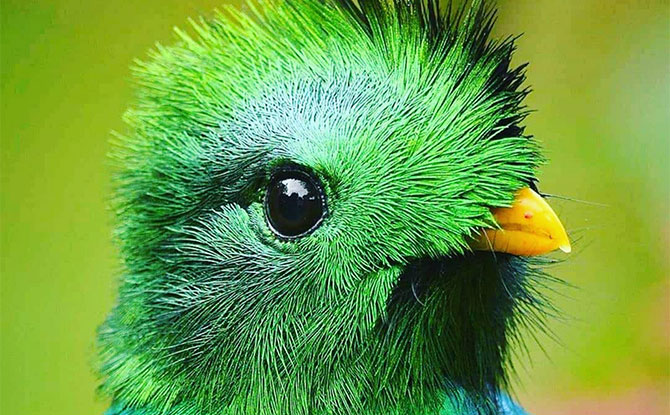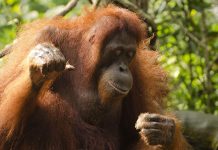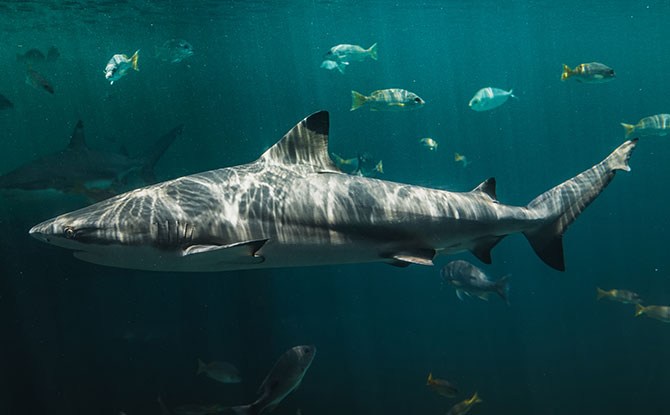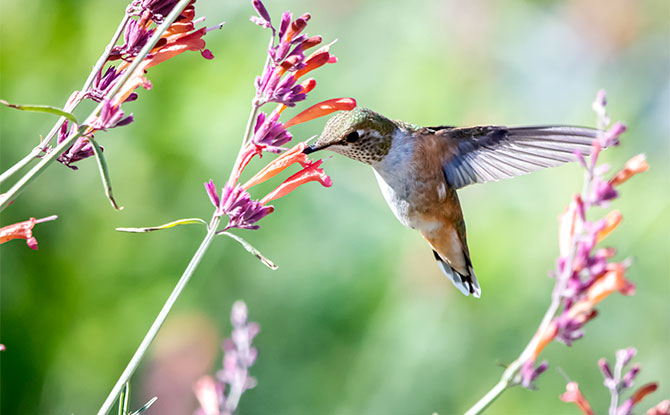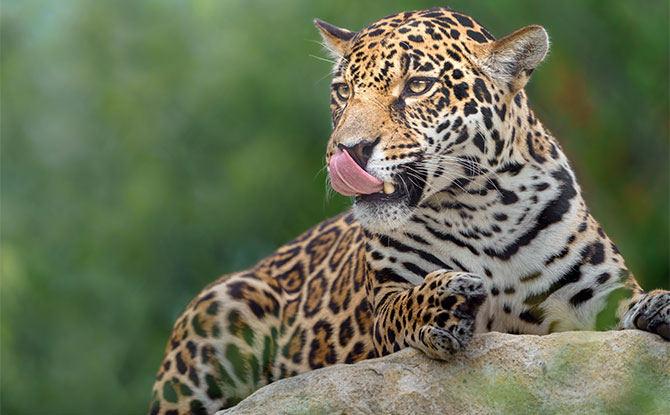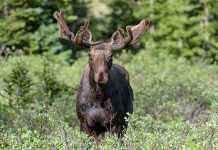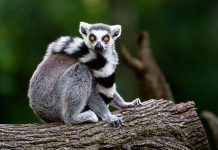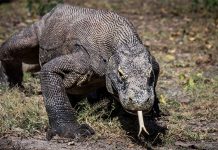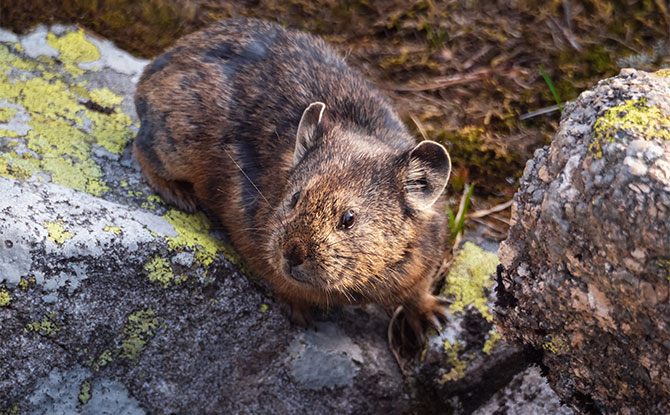

Are you curious about animals starting with P? Look no further! In this article, we will introduce a fascinating variety of animals whose names start with P. From mammals to birds, reptiles to fish, we’ll explore the diverse world of creatures that fall under this category.
Animals Starting with P
Panda
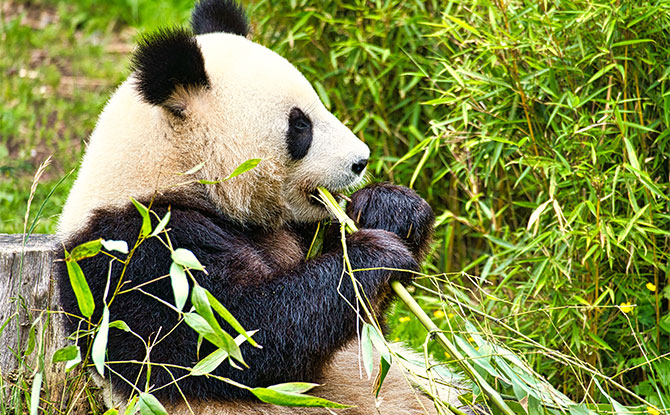

The giant panda, scientifically known as Ailuropoda melanoleuca, is a beloved animal that captivates the hearts of many. This section provides information about the panda’s habitat, diet, and conservation status, as well as interesting facts about their unique adaptations and behaviors.
The panda is primarily found in the mountainous regions of central China, where they inhabit dense bamboo forests. These forests are crucial to their survival, as bamboo makes up more than 99% of their diet. Despite being classified as a carnivore, the panda’s diet consists almost entirely of bamboo shoots, leaves, and stems.
BE PSLE-READY: Join Expert Educators for Revision Boosters to Empower P6 Students
BURP: Join the Sound Collector on a Whimsical Chase at Esplanade – Theatres on the Bay
WEEKEND IDEAS: Get Inspirational Ideas of Things to Do
Due to habitat loss, fragmentation, and poaching, the giant panda is listed as endangered on the IUCN Red List of Threatened Species. Efforts are being made to protect their remaining habitat and establish conservation areas to ensure their long-term survival.
Aside from their conservation status, giant pandas have many interesting characteristics. They have a unique adaptation in the form of a modified wrist bone that works as a thumb, enabling them to grip bamboo stalks with precision. Pandas are also skilled tree climbers despite their large size.
Pandas are known for their gentle and docile nature, spending most of their time eating and resting. They have a specialized digestive system to extract nutrients from the low-nutrient bamboo, and they can consume large quantities in a single day.
Another interesting fact about pandas is their distinctive black and white markings, which aid in camouflage in their natural habitat. The black and white fur provides excellent camouflage against the dappled light and shadows of the bamboo forests.
Penguin


Penguins are fascinating flightless birds that have adapted to life in the Antarctic and other cold regions. They belong to the family Spheniscidae, and their conservation status varies across different species. Penguins have unique characteristics and behaviors that make them truly remarkable.
One of the most notable features of penguins is their habitat. These birds inhabit the Antarctic region, where they brave the extreme cold temperatures and harsh conditions. However, some penguin species can also be found in other parts of the Southern Hemisphere.
When it comes to their diet, penguins primarily feed on fish and other marine creatures. They are excellent swimmers and use their streamlined bodies and strong flippers to navigate through the water. Penguins are known for their remarkable swimming abilities, which allow them to dive deep and catch their prey.
Breeding is a significant aspect of penguin life. Penguins form breeding colonies where they build nests and lay their eggs. The males and females take turns caring for the eggs and raising the chicks. This unique behavior showcases the strong bond within penguin communities.
Penguin conservation status varies based on the species. Some penguin populations are considered vulnerable or endangered due to habitat loss, climate change, and human activities. Efforts are being made to protect and preserve penguin populations and their delicate ecosystems.
In conclusion, penguins are extraordinary flightless birds that have adapted to survive in the harsh Antarctic environment. Their unique habitat, diet, breeding habits, and conservation status make them a subject of great interest and concern. Learn more about these amazing creatures and their vital role in the natural world.
Polar Bear


The polar bear, scientifically known as Ursus maritimus, is a magnificent creature that inhabits the Arctic region. These majestic bears are known for their impressive size and stunning white fur, which helps them blend in with their icy surroundings.
One of the most remarkable adaptations of the polar bear is its ability to survive in the freezing Arctic environment. Their thick layer of blubber and dense fur provide insulation, allowing them to withstand extreme cold temperatures. In addition, their large, powerful paws are perfect for navigating the icy terrain and swimming in the frigid waters.
The primary diet of polar bears consists of seals, which they hunt by patiently waiting near breathing holes in the ice. With their exceptional sense of smell and excellent swimming abilities, polar bears can detect and catch their prey with great efficiency.
Unfortunately, polar bears are facing significant challenges due to climate change. As the Arctic sea ice melts at an alarming rate, polar bears are losing their essential hunting platform. This loss of habitat is causing a decline in their population and has led to their conservation status being listed as vulnerable.
Despite these challenges, polar bears captivate our imagination with their incredible adaptations and behaviors. For example, female polar bears exhibit remarkable maternal care, building dens in the snow to give birth and raise their cubs. Polar bears are also excellent swimmers, capable of covering long distances in search of food.
In conclusion, polar bears are truly remarkable creatures that symbolize the beauty and fragility of the Arctic ecosystem. Understanding their habitat, diet, and adaptations is crucial for their conservation and for raising awareness about the impact of climate change on these magnificent animals.
Peacock


The peacock, scientifically known as Pavo cristatus, is a magnificent bird known for its vibrant and striking plumage. These beautiful birds belong to the family of peafowl and are admired for their colorful feathers and graceful appearance.
Peacocks are native to South Asia and are often found in grasslands, forests, and cultivated areas. They have adapted well to various habitats and are known for their ability to roam freely.
The diet of peacocks primarily consists of seeds, fruits, insects, and small reptiles. They are omnivorous birds and use their sharp beak to extract food from the ground or plants.
One of the most distinctive features of peacocks is their elaborate courtship display. During the mating season, male peacocks display their magnificent feathers in an impressive fan-like arrangement. This striking display is often accompanied by a loud call to attract female peahens.
Despite their mesmerizing beauty, peacocks have faced certain conservation challenges. Factors such as habitat loss, hunting for their feathers and meat, and illegal trade have contributed to a decline in their population. Various conservation efforts are in place to protect and preserve these magnificent birds.
In addition to their cultural significance, peacocks are revered for their symbolism in many cultures. They are associated with beauty, immortality, and spirituality. Their magnificent feathers have been used in art, fashion, and religious ceremonies throughout history.
Peacocks are a captivating and iconic species. Their vibrant feathers, elaborate courtship display, and cultural symbolism make them a beloved bird. However, efforts should continue to ensure their conservation and the protection of their habitat.
Patagonian Mara
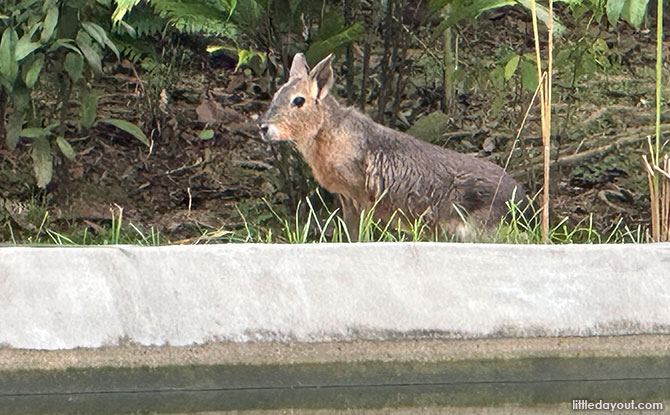

The Patagonian Mara (Dolichotis patagonum) is a remarkable rodent native to the arid regions of Argentina, particularly the Patagonian steppes.
Resembling a cross between a rabbit and a small deer, this unique mammal boasts long, slender legs and large, expressive eyes. Its distinctive appearance is complemented by its coat, which is typically a mix of brown, gray, and white.
Patagonian Maras are highly social animals, often seen in pairs or small family groups, and exhibit monogamous behavior, with pairs typically remaining together for life. Their social structure is fascinating, with multiple pairs often sharing communal burrows, creating a complex network of tunnels that provide protection from predators and harsh environmental conditions.
Patagonian Maras are herbivores, primarily feeding on grasses and other vegetation found in their arid habitats. Their diet and foraging behavior are adapted to the challenging environment, where food can be sparse. Maras are known for their remarkable speed and agility, capable of running swiftly to escape predators, which include birds of prey and terrestrial hunters like foxes.
Panther
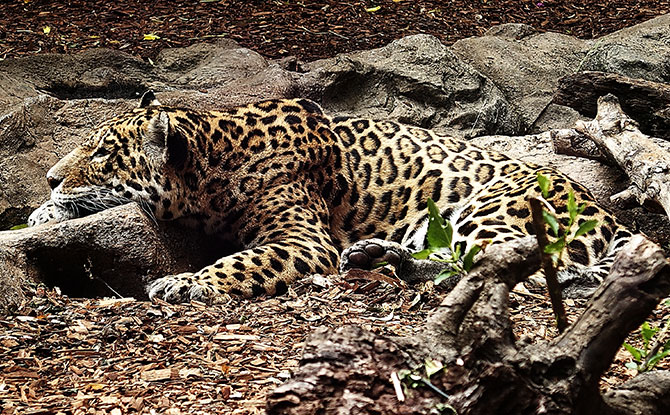

The panther is a fascinating creature that belongs to the Felidae family. It refers to melanistic individuals of the leopard and jaguar species, characterized by their dark coat coloration.
Panthers can be found in various habitats, including dense forests, swamps, and grasslands. They have a wide distribution across different regions, including Africa, Asia, and the Americas.
The diet of panthers primarily consists of small to medium-sized mammals, such as deer, wild boar, and monkeys. They are skilled hunters and their adaptations for hunting include powerful jaws and sharp retractable claws.
One of the most remarkable features of panthers is their ability to camouflage in their surroundings. Their dark coat coloration allows them to blend seamlessly into the shadows, making them virtually invisible to their prey. This camouflage also helps them remain elusive and avoid detection by potential threats.
In terms of conservation, panthers face various challenges due to habitat loss, poaching, and conflict with humans. Their conservation status varies depending on the species and the region they inhabit.
Interesting facts about panthers include their cultural significance in various societies, where they are often associated with symbolism and mythology. Panthers have been featured in many folklore tales and are regarded as formidable and mysterious creatures.
Porcupine
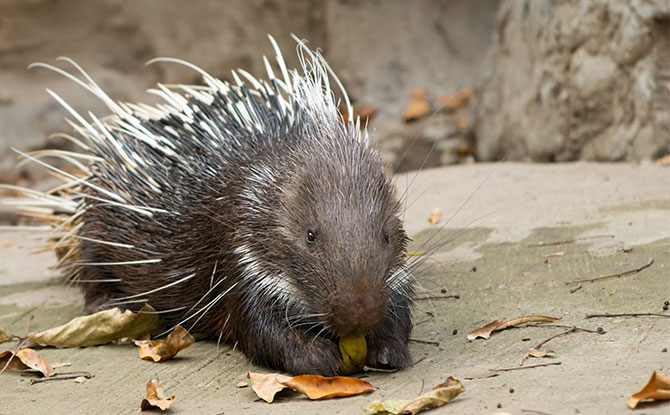

Porcupines, scientifically known as Erethizon dorsatum, are unique rodents known for their spiky quills that cover their bodies. These fascinating creatures can be found in various habitats across North America, including forests, grasslands, and rocky areas.
A porcupine’s diet typically consists of vegetation, including leaves, bark, twigs, and roots. They have adapted to their herbivorous diet with sharp incisors and powerful jaws.
The most distinctive feature of porcupines is their quills. Porcupine quills are modified hairs that come in different sizes and shapes, providing them with an effective defense mechanism against predators. When threatened, porcupines can raise and rattle their quills, creating a formidable deterrent.
Despite their prickly appearance, porcupines are generally peaceful animals that prefer to avoid conflict. However, if threatened, they will use their quills as a form of defense. Contrary to popular belief, porcupines cannot shoot their quills at predators, but the quills are easily detached upon contact, causing them to become embedded in the attacker’s skin.
Porcupines are solitary animals and are primarily active at night. They are skilled climbers and spend a significant amount of time in trees, where they feed on leaves and buds. During the winter, porcupines will often seek shelter in caves, hollow trees, or burrows that they dig themselves.
The conservation status of porcupines varies depending on the specific species and their geographical location. Some populations are considered stable, while others face threats due to habitat loss, deforestation, and human activities. It is important to protect these unique creatures and their habitats to ensure their continued existence.
Porcupines are fascinating rodents with their spiky quills and unique defense mechanisms. They play an important role in their ecosystems and are a vital part of the natural world.
Platypus
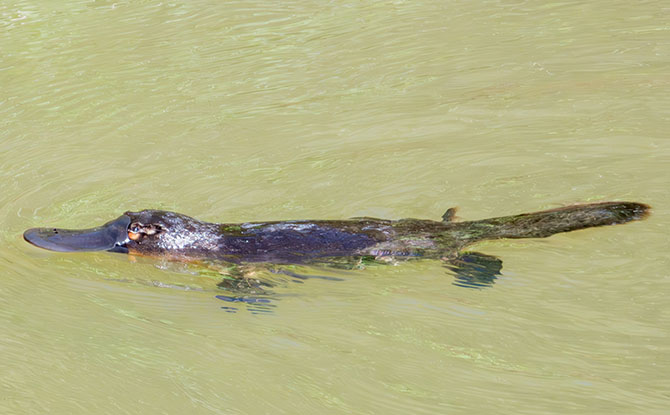

The platypus (Ornithorhynchus anatinus) is a unique and fascinating monotreme mammal found in Australia. It is known for its unusual combination of features, such as its duck-like bill, webbed feet, and venomous spur.
The platypus is well adapted to its semiaquatic lifestyle. It inhabits freshwater streams, rivers, and lakes in eastern Australia, where it builds burrows along the banks for shelter and protection.
The diet of the platypus consists mainly of small invertebrates, such as insects, worms, and crustaceans, which it finds by searching underwater with its sensitive bill. It has the amazing ability to close its eyes, ears, and nostrils while diving, relying on special sensors in its bill to detect its prey.
One of the most unique characteristics of the platypus is its ability to lay eggs, making it one of the few mammals that reproduce in this way. The female platypus lays 1-3 eggs in a nesting chamber within its burrow, where they are incubated for about 10 days before hatching. The young platypuses are nourished with milk produced by the mother, which is secreted through pores in her skin, as it does not have nipples.
The conservation status of the platypus is currently listed as “near threatened” due to threats such as habitat loss, pollution, and climate change. Efforts are being made to protect their habitats and raise awareness about the importance of preserving this unique species.
The platypus is a remarkable and iconic animal that showcases the incredible diversity of Australia’s wildlife. Its adaptations, diet, reproduction, and conservation status make it an intriguing subject of study and a symbol of the country’s natural heritage.
Read about Melbourne Zoo, where you can find a platypus exhibit.
Puma


The puma, also known as the mountain lion or cougar, is a large felid found throughout the Americas. Pumas belong to the Felidae family and their scientific name is Puma concolor. They have a wide distribution, with various subspecies inhabiting different regions across North and South America.
When it comes to habitat, pumas are exceptionally adaptable and can thrive in different environments, including forests, mountains, and even deserts. They have a vast range, from the Yukon in Canada to the southern Andes of South America.
Pumas are carnivorous predators with a diverse diet. Their primary food source consists of ungulates such as deer, but they also prey on smaller mammals, rodents, and occasionally birds. Their hunting techniques involve stealth and agility, as they silently stalk their prey and use their powerful hind legs to pounce and deliver a swift and lethal bite.
Despite their adaptability and impressive hunting skills, pumas face certain conservation challenges due to habitat loss, fragmentation, and conflicts with humans. In some areas, their populations are declining, leading to their classification as a species of “Least Concern” or “Near Threatened” on the conservation status scale, depending on the specific subspecies and region.
Interesting facts about pumas include their ability to jump up to 20 feet vertically and 40 feet horizontally in pursuit of prey. They also have a flexible breeding season, allowing them to adjust their reproductive cycles to the availability of resources. Pumas are solitary animals, with males having larger territories than females, and their elusive nature makes them challenging to observe in the wild.
Puffin
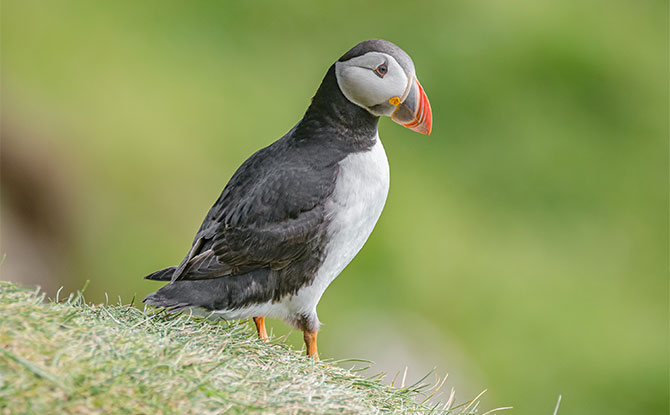

Puffins are adorable seabirds that belong to the genus Fratercula and the order Sphenisciformes. These charismatic birds are known for their colorful beaks and their remarkable ability to dive underwater in search of food.
Puffins can be found in the northern regions of the Atlantic and Pacific Oceans, including the coasts of North America and Europe. They typically inhabit rocky cliffs and islands near the sea, where they can nest in burrows or rocky crevices.
The diet of a puffin mainly consists of small fish, such as herring and sand eels. They catch their prey by diving from the air and using their wings to swim underwater. Their unique adaptations, including their streamlined bodies and specially designed beaks, allow them to excel in these hunting behaviors.
Puffins have an interesting breeding behavior, forming large colonies where they establish their nests. They return to the same nesting sites every year and engage in complex courtship rituals. These breeding colonies are not only important for reproduction but also contribute to the overall conservation of puffin populations.
The conservation status of puffins varies among different species and populations. While some populations are considered to be of least concern, others are vulnerable or endangered due to threats such as habitat loss, climate change, and overfishing. Conservation efforts are crucial to ensuring the long-term survival of these charming seabirds.
Puffins are fascinating seabirds that captivate with their colorful appearance and impressive diving abilities. Their habitat, diet, breeding behavior, and conservation status make them a subject of great interest and importance, deserving of our attention and conservation efforts.
Parrot
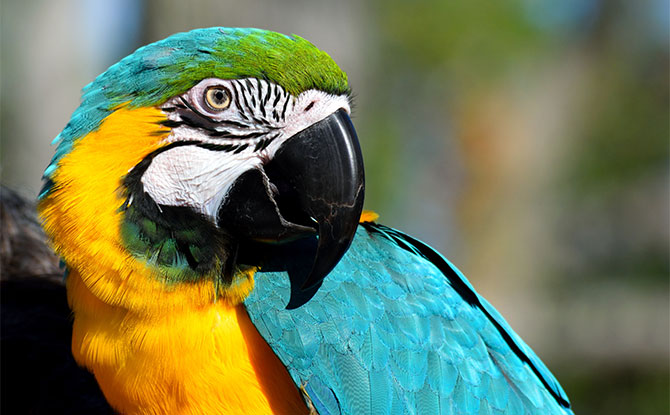

Parrots are a highly intelligent and colorful group of birds belonging to the Psittaciformes order. Known for their remarkable ability to mimic sounds and even speak human words, parrots have captivated the hearts of bird enthusiasts worldwide.
Parrots inhabit diverse habitats across the globe, ranging from tropical rainforests to arid savannas. They can be found in regions such as South America, Australia, Africa, and Southeast Asia. These birds have a varied diet, consisting of fruits, nuts, seeds, and even nectar.
One of the most fascinating features of parrots is their vocal abilities. With their impressive range of calls, squawks, and whistles, parrots can communicate with each other and express their emotions. Their intelligence is also evident in their problem-solving skills and their ability to learn tricks and commands.
Despite their intelligence and popularity as pets, many parrot species are facing conservation challenges. Habitat loss, illegal trapping for the pet trade, and the impact of climate change have resulted in several parrot species being listed as endangered or threatened. Conservation efforts are crucial to protect these magnificent birds and their habitats.
Parrots come in a wide variety of species, each with its unique characteristics and behaviors. From the majestic and critically endangered Spix’s Macaw to the playful and highly social African Grey Parrot, parrots never cease to amaze with their vibrant plumage and captivating personalities.
Parrots are intelligent, vocal, and beautiful birds that deserve our admiration and conservation efforts. Their diverse species and behaviors provide endless fascination for bird enthusiasts and researchers alike.
Pelican
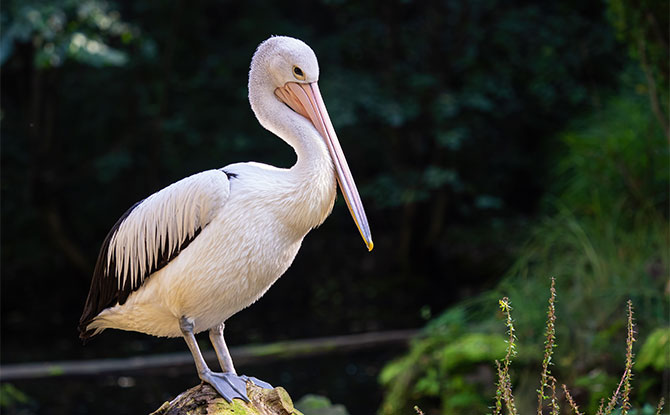

Pelicans are large waterbirds known for their impressive diving abilities and distinctive beaks. These graceful birds belong to the Pelecanus genus and are commonly found around the world.
Pelicans inhabit a variety of habitats, including coastal areas, lakes, and rivers. They have a diverse diet that mainly consists of fish, which they catch using their unique diving behavior. With their long wings and specialized beaks, pelicans excel at plunging into the water to capture their prey.
One of the most remarkable features of pelicans is their distinctive beak. It is long and hooked, helping them scoop up large amounts of water and fish. After catching their prey, they tilt their heads back to drain out the water, leaving behind only the fish.
Pelicans are known for their interesting breeding behavior and the formation of breeding colonies. These colonies can consist of hundreds or even thousands of birds, creating a mesmerizing sight. The preservation of these breeding colonies is crucial for the conservation of pelicans.
In terms of conservation status, pelicans are generally classified as species of least concern. However, certain populations of pelicans, such as the American white pelican, face threats from habitat loss, pollution, and disturbance to their breeding sites.
Pelicans are fascinating birds with their impressive diving abilities, distinctive beaks, and captivating breeding colonies. Understanding and conserving their habitats is essential for ensuring the continued presence of these graceful creatures.
Pangolin
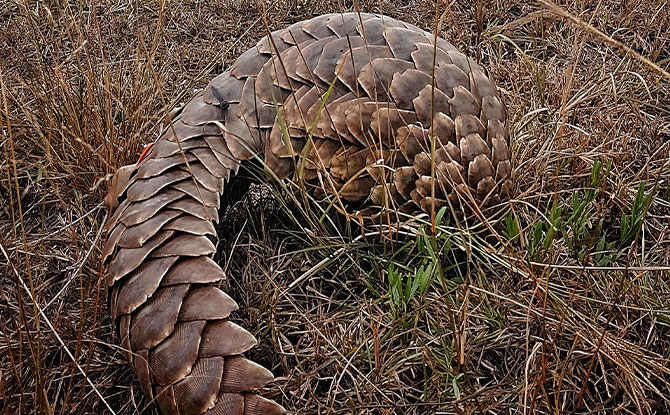
Pangolins, scientifically known as Pholidota, are fascinating mammals that belong to the order Pholidota. They are commonly referred to as scaly anteaters, as their bodies are covered in unique scales that provide them with protection from predators. Pangolins are found in various habitats across Africa and Asia, including forests, grasslands, and savannas.
The diet of pangolins mainly consists of ants and termites, making them excellent pest controllers in their respective ecosystems. Their long, sticky tongues enable them to capture their prey with ease. Apart from their remarkable feeding habits, pangolins are known for their distinctive scale armor, which is formed from keratin, the same material found in human hair and nails. These scales serve as a shield against potential threats.
Pangolins play a crucial role in maintaining the balance of their ecosystems. They provide ecological services by controlling insect populations, aerating the soil, and dispersing seeds. Unfortunately, pangolins are currently facing a severe conservation crisis. Due to their high demand in illegal wildlife trade, they are among the most trafficked animals in the world.
Efforts are being made to protect pangolins and raise awareness about their conservation status. International organizations and governments are working together to combat the illegal trade and enforce stricter regulations. It is important to understand the importance of these unique creatures and support their conservation to ensure their survival in the wild.
Peregrine Falcon


The peregrine falcon, scientifically known as Falco peregrinus, is an impressive bird renowned for its unmatched speed and agility. It holds the title of the fastest animal on Earth and is a symbol of power and precision in the bird kingdom.
The habitat of peregrine falcons spans across various continents, including North America, Europe, and Asia. These majestic birds can be found in diverse environments such as mountains, cliffs, and urban areas. They have adapted well to human presence, often nesting on tall buildings and bridges.
Peregrine falcons have a diverse diet that primarily consists of other birds. They are masterful hunters, known for their unique hunting technique called the “stoop.” This involves a high-speed dive towards their prey with astonishing precision and accuracy. With their hunting speed reaching up to 240 miles per hour, they can swiftly capture their targets mid-flight.
Despite their incredible hunting abilities, peregrine falcons faced significant population declines in the past due to the use of pesticides such as DDT. However, conservation efforts and the banning of these harmful chemicals have led to a remarkable recovery of their populations. Today, their conservation status is stable, thanks to dedicated conservation programs and the protection of their habitats.
Interesting facts about peregrine falcons include their exceptional eyesight, which allows them to spot their prey from high altitudes. They can locate distant objects with great clarity, thanks to a specialized fovea in their retina. Peregrine falcons also exhibit fascinating nesting behavior, often reusing their nests year after year, and mating for life.
Python


Pythons, belonging to the Pythonidae family, are impressive snakes known for their ability to constrict their prey. These large constrictor snakes have a fascinating hunting behavior that involves coiling their powerful bodies around their victims and squeezing them until they suffocate. One of the most well-known species of python is the reticulated python (Python reticulatus), which can grow to be one of the largest snakes in the world.
Pythons have a wide habitat range, inhabiting diverse environments such as tropical rainforests, grasslands, and even deserts. They can be found in Africa, Asia, and Australia. These adaptable snakes have also been introduced to other parts of the world due to the pet trade.
When it comes to their diet, pythons are carnivorous, feeding on a variety of prey depending on their size and habitat. Their diet consists mainly of small to medium-sized mammals, birds, and reptiles. Pythons are known for their ability to swallow their prey whole, thanks to their flexible jaws and expandable stomachs. This unique feeding behavior allows them to consume prey much larger than their own heads.
While pythons may not be venomous, their strong constricting ability makes them formidable predators. They use their muscular bodies to subdue and immobilize their prey, squeezing tightly until the prey’s heart stops beating. Pythons have been observed to use ambush hunting techniques, lying in wait until prey comes within striking distance.
Pythons face various threats such as habitat loss and degradation, illegal wildlife trade, and persecution due to the perception of danger to human safety. Some python species are listed as endangered or vulnerable, highlighting the need for conservation efforts to protect these remarkable snakes.
Interesting python facts include their impressive size, with some individuals reaching lengths of over 20 feet. Pythons also exhibit a unique method of reproduction called oviparity, where the female lays eggs that later hatch into independent snakelings. This method of reproduction is different from other types of snakes that give live birth.
Pythons are fascinating creatures with their ability to constrict prey, adapt to various habitats, and their impressive size. Understanding and conserving these magnificent snakes is crucial for maintaining the balance of ecosystems where they reside.
Pigeon


Pigeons are adaptable birds found in both urban and rural areas around the world. These birds, belonging to the Columba genus, have a long history of coexisting with humans. Pigeons are known for their ability to thrive in city environments, making them a familiar sight in cities across the globe.
The diet of pigeons consists mainly of seeds, grains, fruits, and small insects. Their adaptable nature allows them to find food in various urban settings, such as parks, rooftops, and sidewalks.
Pigeons have several adaptations that make them well-suited to urban environments. They have a strong homing instinct, allowing them to navigate and return to their roosting sites. This ability has made pigeons useful messengers throughout history.
Pigeons also have an exceptional memory and can recognize landmarks, further aiding their navigation in urban areas. Their ability to fly at high speeds enables them to traverse large distances to find food and water sources.
Despite their adaptability, pigeons face conservation challenges in some regions due to habitat loss, pollution, and predation. Efforts are being made to protect and conserve pigeon populations due to their cultural significance and ecological roles.
Interesting facts about pigeons include their ability to recognize themselves in mirrors, their remarkable courtship displays, and their contributions to scientific research on animal cognition.
Pigeons are remarkable birds that have adapted to and thrived in urban environments. Their ability to navigate, their diverse diet, and their unique adaptations make them a fascinating subject for study.
Pika


Pikas are small rodent-like mammals that belong to the family Ochotonidae. They are known for their presence in alpine habitats, specifically in rugged mountain environments. These adorable creatures have unique adaptations that allow them to thrive in their harsh alpine habitats, making them a fascinating species to study.
The habitat of pikas is primarily found in rocky slopes and talus fields, where they build elaborate burrow systems. These burrows provide them with shelter and protection from extreme temperatures and predators. Pikas have also developed physical adaptations to survive in their alpine homes, such as dense fur that helps to insulate them in cold climates.
The diet of pikas mainly consists of vegetation, including grasses, herbs, and shrubs. They have a remarkable ability to gather and store large amounts of plant material during the summer months, which they use as a food source during the winter when fresh vegetation is scarce.
Pikas are known for their high-pitched alarm calls, which they use to communicate with each other and alert their colony members of potential threats. These vocalizations are essential for their survival in alpine environments where visibility may be limited.
Despite their adorable appearance and fascinating behaviors, pikas face several conservation challenges. They are considered indicators of climate change because they are highly sensitive to temperature fluctuations. As global temperatures rise, pikas are at risk of losing their alpine habitats, putting their populations in danger.
Efforts are being made to protect and conserve pikas and their alpine habitats. Monitoring their populations, conserving suitable habitat areas, and raising awareness about their conservation status are vital steps in ensuring their survival for future generations.
Pikas are remarkable creatures that have adapted to thrive in alpine environments. Their unique adaptations, diet, and vocalizations are fascinating aspects of their behavior.
Pheasant
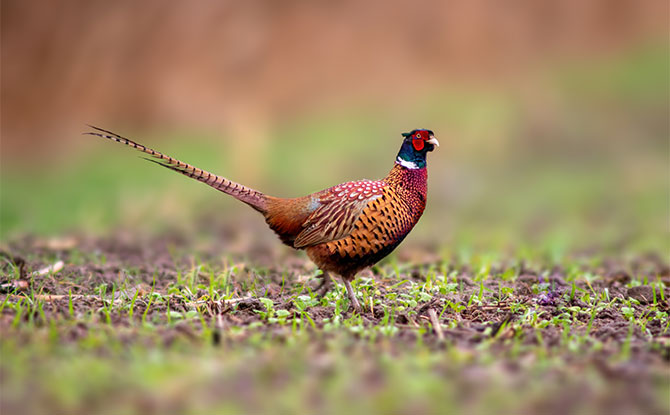

Pheasants are beautifully colored game birds known for their vibrant plumage and popularity as hunting targets. These birds belong to the Phasianus genus, which includes several species. Pheasants are typically characterized by their long tails and striking patterns on their feathers.
The habitat of pheasants varies depending on the species, but they are predominantly found in grassy fields, woodlands, and agricultural areas. They are native to Asia but have been introduced to many other parts of the world for game bird hunting purposes.
Pheasants have an omnivorous diet, consisting of grains, seeds, fruits, insects, and small animals. Their feeding habits often involve scratching the ground to find food.
Game bird hunting is a popular recreational activity that involves the pursuit of pheasants. These birds are valued for their ability to fly and make challenging targets for hunters. However, strict hunting regulations and conservation efforts are in place to ensure sustainable populations and protect their conservation status.
Interesting facts about pheasants include their elaborate courtship displays, where males often strut, puff out their chests, and fan their tails to attract females. Pheasants also have preferred habitats with adequate cover and food sources.
Praying Mantis
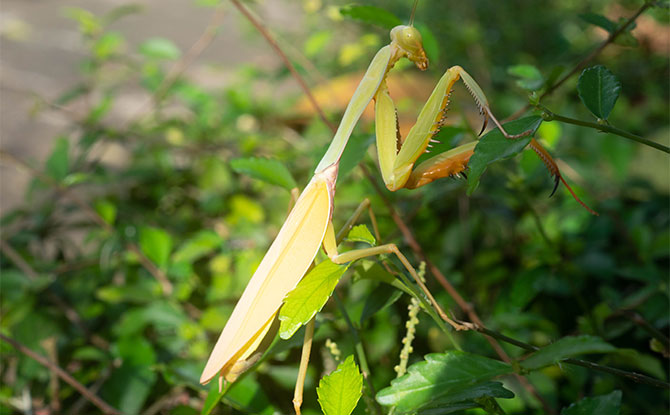

Praying mantises, belonging to the order Mantodea, are intriguing insects known for their unique body shape and predatory behavior. These fascinating creatures have captured the interest of both scientists and nature enthusiasts worldwide.
Praying mantises can be found in various habitats, including forests, grasslands, and gardens. They are highly adaptable and have successfully established populations across different regions.
The diet of praying mantises primarily consists of other insects such as flies, crickets, and moths. Their remarkable hunting strategy involves sitting motionless and patiently waiting for prey to come within striking distance. Once a suitable target is within reach, the mantis swiftly grabs it with its powerful front legs and devours it.
One of the most distinctive features of praying mantises is their unique predatory behavior. These insects have the ability to rotate their heads nearly 180 degrees, allowing them to spot potential prey from a wide range of angles. Additionally, some species of mantises exhibit fascinating camouflage techniques, blending in seamlessly with their surroundings to avoid detection.
Despite their predatory prowess, praying mantises themselves are at risk due to habitat loss, pesticide use, and other factors. As a result, conservation efforts to protect these remarkable insects are imperative.
Praying mantises have a fascinating reproductive process. After mating, the female may practice sexual cannibalism, where she consumes the male. This behavior is believed to provide essential nutrients for the female’s offspring.
Most praying mantises have wings and are capable of short flights, allowing them to quickly move between hunting grounds or escape predators.
Praying mantises also have unique defense mechanisms. When threatened, they may display their forelegs and spread their wings to appear larger and more intimidating. Some species even produce hissing sounds or release foul-smelling chemicals to deter predators.
Praying mantises are remarkable insects known for their distinctive body shape and predatory behavior. Their unique hunting strategies and fascinating adaptations make them a captivating subject of study and observation. However, their conservation status highlights the need for ongoing efforts to protect these extraordinary creatures and preserve their habitats.
Prawn
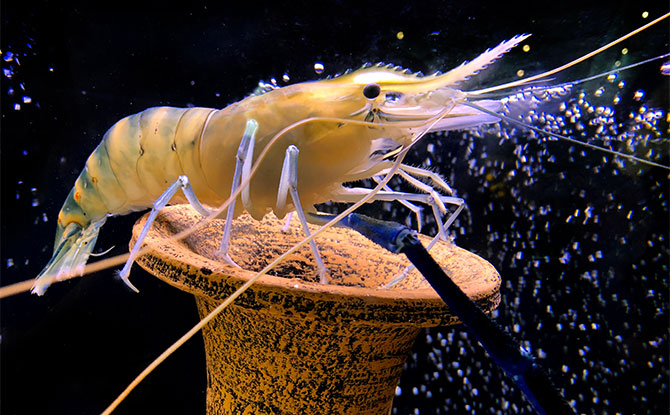

Prawns are decapod crustaceans that are widely enjoyed as seafood in many cultures around the world. They are known for their delicate and succulent meat, making them a popular choice for various culinary preparations.
Prawns can be found in both coastal and freshwater habitats, depending on the species. They are typically found in warm waters and are often associated with marine ecosystems, such as coral reefs and seagrass beds.
The diet of prawns consists mainly of small organisms, including plankton, algae, and small fish. They are opportunistic feeders and play an important role in the marine food chain.
When it comes to culinary uses, prawns are highly versatile and can be prepared in a variety of ways. They can be grilled, boiled, stir-fried, or used in soups, stews, and seafood pasta dishes. Their sweet and juicy meat adds a flavorful touch to any recipe.
Piranha
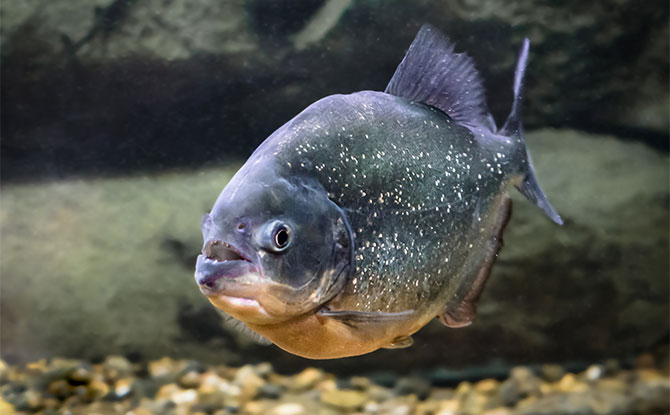

Piranhas are infamous freshwater fish known for their sharp teeth and aggressive feeding behavior. Belonging to the family Serrasalmidae, they are native to South American rivers and basins. Piranhas have a notorious reputation due to their ability to tear apart their prey using their razor-sharp teeth.
These carnivorous fish have a diverse diet that includes other fish, insects, crustaceans, and even small mammals. Their hunting strategies involve both solitary and group behavior, where they work together to overwhelm their prey.
Piranhas are essential for the balance of their habitat and play a crucial role in controlling the population of other aquatic species. Despite their fearsome reputation, piranhas are not typically a threat to humans and are more interested in scavenging or avoiding potential threats.
The conservation status of piranhas varies depending on the species. While some species are classified as least concern, others are facing threats due to habitat destruction, overfishing, and pollution. Efforts are being made to protect their natural habitats and promote sustainable fishing practices to ensure the survival of piranhas and the healthy ecosystems they inhabit.
Interesting piranha facts include their social behavior, hierarchical structure within groups, and their ability to change colors depending on their mood. Additionally, these fascinating fish have been the subject of numerous myths and misconceptions due to their portrayal in popular culture.
Parrotfish
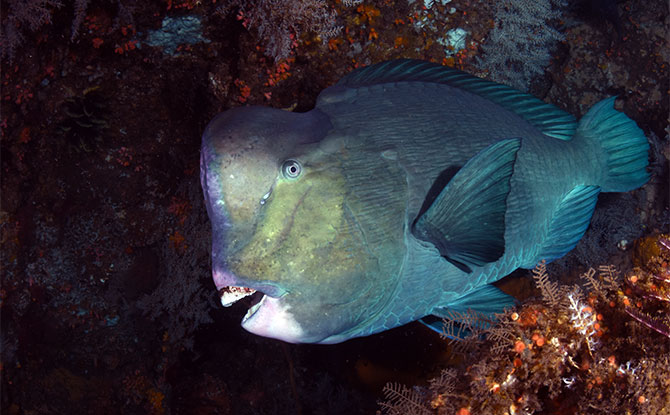

Parrotfish, part of the Scaridae family, are a stunning sight in coral reefs. Their vibrant colors make them stand out among the marine life, but their importance goes far beyond their striking appearance. These fascinating creatures play a crucial role in maintaining the health and balance of coral reef ecosystems.
Parrotfish are primarily herbivores, feasting on a diet consisting of algae, coral polyps, and other small organisms found within the reef. As they graze, their unique beak-like teeth help them scrape algae from the coral, inadvertently aiding in the prevention of coral overgrowth, which could suffocate and harm the reef.
Another remarkable characteristic of parrotfish is their ability to produce a protective mucus cocoon that surrounds their body when they rest at night. This cocoon acts as a barrier against predators and pathogens. Interestingly, parrotfish are also known for their “sex-changing” ability, with some individuals transitioning from female to male as they mature.
If you have enjoyed this look at animals that start with P, we think that you will also be fascinated by these animals that start with O and these animals that start with Q.









